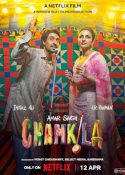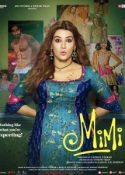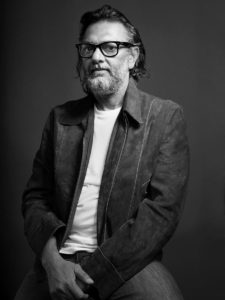 From the heartbreaking but brilliant Rang De Basanti, to the wonderful Delhi 6, to the inspiring Bhaag Milkha Bhaag, director Rakeysh Omprakash Mehra has brought Indian cinema some of its greatest films.
From the heartbreaking but brilliant Rang De Basanti, to the wonderful Delhi 6, to the inspiring Bhaag Milkha Bhaag, director Rakeysh Omprakash Mehra has brought Indian cinema some of its greatest films.
With his film Mirzya, he has now turned his focus on the Punjabi folk tale Mirza-Sahiban, but presenting it in a unique way. Interweaving the legendary folklore with a contemporary version, this musical brings out the story of a love that will never die. Joining him in transforming this story is the esteemed writer and poet Gulzar. Adding to the worlds of Mirzya is music by the great Shankar, Ehsaan and Loy.
Mirzya introduces Harshvardhan Kapoor and Saiyami Kher, along with Anuj Chaudhary. Also bringing the story to life are the screen masters, Om Puri, Art Malik, and K. K. Raina.
Some of my absolute favorite interviews to conduct are with directors because they just love talking about their movies. With Mr. Mehra, an interview with him… it is even more. He narrates to you, he talks to you in-depth about filming, he lets you in, you learn, you get inspired, you throw away your questions and just listen but as it goes on find new ones, you hear his passion and it makes you want to see his movie even more. It is an amazing experience. Presenting Mr. Rakeysh Omprakash Mehra and his tale of Mirzya.
The Sahiban Question
Stacey, I happened to see the play, during my college, which was around 35 years ago. It is a very interesting play; it is almost like a Shakespearean tragedy – it is in fact. It has a likeness to Romeo and Juliet – Heer Ranjha, a tragic love story. What really attracted me was that there was a very strong female character. She was extremely proud of her beauty. She was almost vain. She would use her beauty on men. She had these brothers who doted on her. But then love is a crazy thing – it is totally illogical. Mirza was her childhood friend. When he comes back into her life after a gap of 15-20 years their families don’t see eye to eye.
(Spoiler alert: if you don’t know the tale and want to see it come alive onscreen skip to the next section)
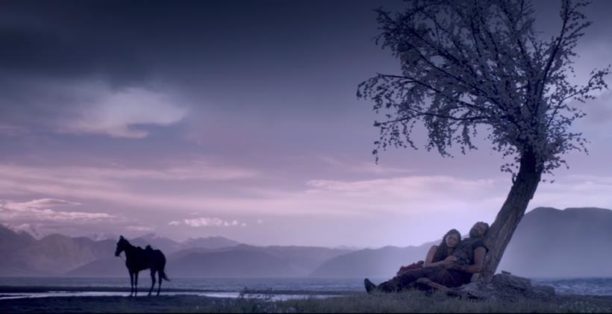
They are from warring tribes – they are from opposite sides. But love beckons and they fall in love. They realize that it is more than love – they are soulmates. Obviously the families don’t agree, society doesn’t agree, the politics do not agree – so they elope. They run away on her marriage night. Now, Mirza is more like a very Sufi kind of character. He is an extremely good horseman and he is great with archery. He is in the district and in the mountains of the northwest frontier and his name is known far and wide. So they travel on a horse, they ride 3 nights and 4 days. On the fourth night, it is getting dark and they are almost about to reach the safety of his valley. They can’t see their way anymore so they decide to stop and they sleep under a tree. It is turning dawn and that is when the brothers come and one by one Mirza kills all the brothers, because he is so cool with the bow and arrow. There are also a hundred people in pursuit, but he is better than all of them. Then she wakes up… it was a dream, it was a nightmare. In that moment of catharsis, she takes out his arrows from his quivers and she breaks them, she breaks them up one by one. Then the dream comes true, the brothers and the posse of a hundred horses come. Mirza wakes up, he picks up his bow and he looks around and all his arrows are broken. He looks at Sahiban and he has a question in his eyes: Why? She has a teardrop in her eyes and I think he gets his answer. He gets shot, many arrows are fired into him and he dies. And Sahiban is taken away. It is a unique story.
So at the end of the play [that I saw in college], the director would come and ask, ‘So why did Sahiban break the arrows?’ And the audience would answer: someone would say, ‘She wanted to save her brothers’, another: ‘She didn’t want bloodshed’, or ‘She would have talked it over with the brother’s but it just happened to fast’. You know, it stayed with me somewhere…‘Why did she break the arrows?’
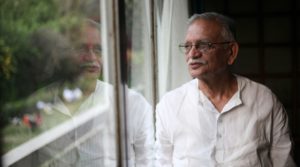 So it begins…with Gulzar
So it begins…with Gulzar
Then you find yourself in the director’s chair, you want to tell stories that kind of have been bothering you somewhere inside of you, and in this way you are looking for answers for those unanswered kind of questions.
So I went to Gulzar-bhai, the legendary writer, lyricist, and poet. He is the greatest poet we have ever had – not only in movies but otherwise in literature. He is my neighbor and I called him up and said, ‘A cup of tea?’ He said, ‘Okay, hop across’; we do that all the time. It is just great to talk with him and hang out with him. There is so much he can give you. So I said, ‘Gulzar-bhai, Why did Sahiban break the arrows?’ He calls me Bacchu, which means son and he says, ‘Bacchu, why don’t you go ask Sahiban?’ I said, ‘I have been looking for her for all this while, she seems to be alluding me.’ He had this twinkle in his eyes and he said, ‘Okay let’s find it out together.’ So we started the journey of writing this film. Without me even asking he agreed to write, even after giving up writing screenplays. He always wrote for himself when he was a director. He has not been writing screenplays for the last 15 years. He was concentrating more on poetry and lyrics and books – he has almost been churning out two books a year for the last 5-7 years and he is 84.
It was great to just go through the process of discovering the varied facets of love. This strong woman character, this amazing love and the other love she has that she is engaged too. Trying to understand the various colors of this thing we call love and what the hell it is. And why did she break the arrows?!? So we went along on that journey and somewhere along the way I think I got my answers, which is what I am sharing with the world at large.
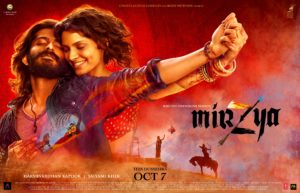 The Tale In Today’s Time
The Tale In Today’s Time
But it did not stop there. I told Gulzar-bhai folktales are folktales, what if something like this, or the essence of the story of Mirza-Sahiban played out in today’s time. How would it unfold itself? Now that made it even more interesting. So we took the folklore of Mirza-Sahiban and you can hear the echo or the reverberation in today’s time in 2016 in Rajasthan. It is played out with contemporary characters in today’s India. That made it much more interesting.
A Step Further
Then we went a step further. We were having so much fun we said why stop, why not do a musical? He said, ‘Hey, every Hindi film or Indian movie by default is a musical… actors are always singing, they are dancing… so how?’ I said, ‘Yes, but we need to invent a musical because I have never seen my actors sing and dance.’ In Rang De Basanti, Delhi 6 or Bhaag Milkha Bhaag, nobody ever sang or danced. I used music but I used it as background. The music is done well because I am a radio guy, I grew up on radio. I have listened to music but I have never seen music. So we said let’s turn it into a musical.
Then we had a gypsy narrator, who would narrate the great folklore of Mirza-Sahiban. We enter the folklore world, which is in my imagination, so it doesn’t play out in the past, in the present or in the future – it just plays out in an imaginary world, which is the beautiful northwest frontier, the mountains of Ladakh. There we told this larger than life story.
About the gypsies, I remember watching a documentary Latcho Drum, it is a French documentary, and it won an Oscar. In the film they had traced the iron smiths of Rajasthan, the gypsies and the nomads who would, after a hard day’s work in the sun with the fire and working with the iron, in the evening they would light a fire around the trees and narrate stories and sing and dance. The documentary followed this same tradition trough Afghanistan, Persia, Iran, Iraq, Egypt, Turkey, Russia, Romania, then east to France and Spain. It is the same line, it is the same kind of dance movements. It changes from the Rajasthani – Gujarati Garba and it becomes Flamenco somewhere. It becomes a salsa somewhere. It is crazy.
Mirzya is a nonlinear story, which is interwoven between three worlds actually: the gypsies who sing and narrate this, who celebrate the idea of love, the folklore world and the real world today. There comes a point when these lines which are running parallel, these stories when they kind of meet each other and then the lines blur. You don’t know where you are.
It was fun exploring this and somewhere finding the answer to one stupid question, ‘Why did Sahiban break the arrows?’
 So why did Sahiban break the arrows or do we have to wait to see the movie?
So why did Sahiban break the arrows or do we have to wait to see the movie?
I would say, to each one its own. You leave it to the audience. I never try to define things to the audience in so much black and white. I don’t think that is how it plays out, especially when you are talking about love. Let everybody find their own answer. I think I found mine. You know, you really hurt them the most whom you love the most. For Sahiban, it was a sacrifice when she was breaking the arrows. When I entered Sahiban’s body and started thinking like her and when I actually broke the arrows I could feel my emotions welling up. I could feel the tears and I knew that my brothers are not going to spare him and that I am sacrificing him right now. Mirza, even before and as the arrow goes through him, he looks at her, he knows that not only has he just saved the brothers but their wives and children. He dies with a smile. So there is a kind of mystery.
The most beautiful thing and part is that it is like a 2 hour 10 minute film, out of which let’s say 40 minutes play out in folklore and those 40-50 minutes is silent cinema. There are no spoken lines, there are no songs, it is just pictures. That is the purest form of cinema I could get – as close to it I could get.
Weaving all 3 together
I think in cinema, compared to any other art form, we are blessed with editing. Acting is acting – it comes from folk theater. Cinematography comes from the Renaissance and the painting and the lighting of God. Every art form, you know, we practice in cinema. The writer comes from the great tradition of writing that has come down the line for the last 10,000 years. Narrators are storytellers and there have been storytellers down the ages. Editing is the only art form, which is born because of the birth of cinema. It had never existed in the human psyche or any other form – ever. Today with things going digital, screenplays evolving, society is evolving. I think we can tell non-linear stories. I have been trying to dabble in them with Rang De Basanti here and there, in Bhaag Milkha Bhaag going between childhood and Milkha today and going to 1947 partition India. So it is kind of great fun because as an individual I see something and it takes me somewhere else. So why not try to give that experience to the audience?
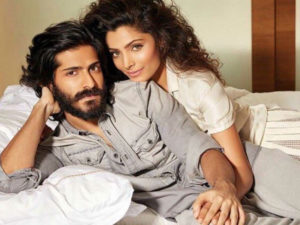 The Cast
The Cast
You have your screenplay – so the next question is who is going to play the role? Every time I used to shut my eyes and we used to write these names down, it never felt right, because every time you thought of an established actor; his image kind of preceded the character. Especially for the Indian audience, you are so aware of these stars. You know that they enter the theater to meet their favorite stars and they want to enjoy them doing the same thing again and again. I really wanted, and it was quite evident, that we were looking for new faces. So the casting process started. I found my Sahiban from Nasik – Saiyami Kher. She had dabbled into modeling a bit. The casting director from Bombay, he got her for the auditions.
Harsh, I had met him several years ago, when I was shooting with Sonam. He dropped by the sets of Delhi 6. He was a 19-year-old lad and I told him, ‘Hey, you have got great eyes, ever think of acting?’ He said, ‘It is in the blood, sir. It is in the family. I don’t think that I can ever escape that.’ I said, ‘Wonderful. How do you feel about it?’ He said, ‘I feel like I have to learn a lot yet and I want to do it for the right reasons.’ And I said, ‘Okay give me a shout when you are ready.’ So he gave me a shout when he was ready. (Laughs) While we were auditioning all the boys he messaged and said, ‘Sir, I am ready can I come see you?’
Then there is a third newcomer Anuj Chaudhary and he is from Delhi. He plays the pivotal role of the other boy in her life. He is so much in love with this girl and she is so much in love with him and they are even engaged. Yet, how love plays out – it is a crazy thing. You can fall in love with more than one man at the same time. I really was trying to explore those emotions, you know. Can I fall in love with more than one person? There will come a time when I will have to make the difficult choice. How long can I lie my way through life? There will be a time when I am at the crossroads.
There is another wonderful cameo role by Anjali Patil. She is another newcomer to Hindi cinema. So four youngsters… absolutely they brought great energy on the sets.
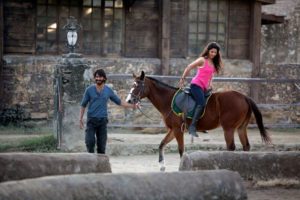 Let me share something with you. There is so much to learn from the newcomers. They have a new approach in the way they go about things. I started seeing the world through their eyes, which was very important I think and very interesting. I have a 16-year-old daughter and she has every which way reinvented me. (Laughs) She is turning 17 and you can imagine what is going on. (Laughs) I cannot tell you how much I enjoy seeing the world through her eyes and how she perceives things. How and what are her responses and what are my responses to the same thing… it is just absolutely amazing. It was a learning process from both ends: on one side I had an 84-year-old Gulzar and on the other side I had all these youngsters and WOW!
Let me share something with you. There is so much to learn from the newcomers. They have a new approach in the way they go about things. I started seeing the world through their eyes, which was very important I think and very interesting. I have a 16-year-old daughter and she has every which way reinvented me. (Laughs) She is turning 17 and you can imagine what is going on. (Laughs) I cannot tell you how much I enjoy seeing the world through her eyes and how she perceives things. How and what are her responses and what are my responses to the same thing… it is just absolutely amazing. It was a learning process from both ends: on one side I had an 84-year-old Gulzar and on the other side I had all these youngsters and WOW!
What a fascinating creative experience…
Yes! Then we had three masters in Art Malik, Om Puri and KK Raina. Art Malik plays Saiyami’s father. He is one of my favorites. He did a small role in Milkha playing Milkha’s father. We had a great mix. It was fun!
New Cinematography
Then I said hey, let’s get a new set of eyes. I started looking for Directors of Photography. I found Pawel Dyllus from Poland. Poland has given us a world of legendary cinematographers. When I spoke to him, Pawel was right there, he got it. In the first Skype chat we knew that we are understanding each other’s soul. He’s young, he is 32, and he brought another sensibility to the whole equation. The best thing is that I got him six months before the shooting so he was with me all the way through.
To me the folklore sections had almost like a painting feel and look to it…
Every time I looked through the camera, my only thing to Pawel was, ‘Listen, it has to be in my imagination. It is not a dream, but it has to be surreal. Surreal in a very pleasant way. Surreal in a way that I get a feeling that hey I have been here or have I been here?’ It was a beautiful experience. Ladakh is so beautiful and that is where we picturised this. It was amazing.
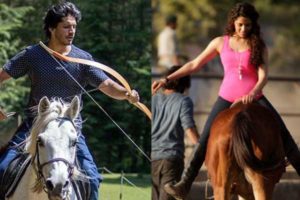 Stunts, horses and archery
Stunts, horses and archery
There was so much mounted archery on horses in Mirzya’s folklore world and it is like larger than life. In Indian cinema, we don’t have the tradition of horses anymore. In our modern Indian cinema we don’t see horses at all and we don’t see horse stunts. So I started going through various movies and I realized I loved this movie The Last Samurai with Tom Cruise. I loved the guy who did the horse work and stunts. He actually doubled for Tom Cruise. He [Danny Baldwin] is from Australia, the Gold Coast. I was visiting Melbourne and I just gave him a shout and I said, ‘Do you mind flying over to meet me?’ He said, ‘No no, not at all. You have flown all the way from India so I don’t mind.’ We sat and we spoke and we hit it off. He has grown up with horses. He’s such a great horseman. He loves and he understands that space and he brought so much on the table. He came here and he trained the actors: he trained Harsh, he trained Saiyami, and he trained Anuj.
You know Stacey, you don’t find mounted archers any more. It is not like any Olympic sport or anything. The only places where it has survived is one or two pockets in Japan, just for sake of keeping a tradition alive there are like these clubs, and then in Poland and in Turkey. We had these 15 mounted archers from Poland, who also played Sahiban’s brothers.
So the crew – it could be anywhere in the world. It was great.
 Incredible Music
Incredible Music
It took us around a year and a half. As I told you last time we talked, I started talking to Shankar and Ehsaan and Loy about it while we were finishing Bhaag Milkha Bhaag. We were already discovering the sound of it, getting more into the story. We had sessions after sessions where either I was cooking and Shankar was eating…you know we don’t know when the music happened actually. We were just eating. It was great.
I invented a term – Gulzariyan, which is the world of Gulzar. It means whatever words come out of him is something called Gulzariyan and it will be poetry.
With Shankar, he is so infectious. I had to stop him all the time saying, ‘No, we are not going to compose today. We are not going to do anything.’ You know, you give him a line, he starts singing and whatever he sings just works out. You just love it. There were no formal sessions. It was just sitting on a sofa with a dictaphone with a mic in your hand and that became a song and we kept it like that.
Then the amazing voices
There is Sain Zahoor who is from Pakistan; he is a Sufi saint and he also sings. You will find him in mosques and Durgas. He believes in Rumi, he believes in Kabir, he believes in Bulleh Shah. He does not know how to read or write. He has never gone to school. Somehow we traced him down and we got him from Pakistan and we used his voice.
There was Daler Mehndi from Delhi; he is a classical folk singer, Bollywood and also does rock and pop and stuff like that. We found the soul in Daler.
There is a small village in Rajasthan called Phulia and beyond that is just desert and nothing else. In between that desert there is a small village, which has a tradition for thousands of years of these Sarangi players, and singers and there we found Mame Khan.
Then we got the Nooran sisters from Punjab, they are Sufi singers and they sing ghazals in mosques and streets and they have done music for Bollywood. They are absolutely amazing.
Here’s another story. I told my friend in law, ‘I am looking for a voice and an expression of storytellers. I don’t care what they sing, I just want to feel it!’ He said, ‘I think I know just the guy! You give me some time I have to find him.’ I said, ‘What do you mean?’ He said, ‘We have to find him. He lives somewhere in Baluchistan, in the mountains in the forest.’ He went and he got me this gentleman who came dressed in this whole traditional outfit from Baluchistan. He didn’t know Hindi and he didn’t know English. He just sang in Balochi. And we used that Balochi in the film! It is just a feeling. When he sang, when we gave him the tune – he improvised. We then figured out what the meaning was… It was about two lovers in the mountains and the boy leaves and he never comes back. (Yes, I am gasping as I hear this -Stacey) He promises the girl and she is just waiting for him forever. So everything was connecting and the universe was conspiring.
This music is world music. I think it is their best! Shankar has just outdone himself.
 What is the essence of Mirzya?
What is the essence of Mirzya?
Ahhh… (Pauses to think). I think it is when you are in love, you need not define it in relationships… at all. You should never fall in love, but it is not in your hands. All of us are lucky to brush with love at some point in our life. And then we try to give it a name. We try to give it a relation. We try to create a social bond out of it. I think when you see two people in love you should just let them be. That’s it. There should be no conditions there – there should be nothing. You see, there are sides of love in the story, you won’t see jealousy so much, you’ll see sacrifice, and you’ll see possessiveness.
There is an amazing father/daughter relationship in the film, which Art Malik and Saiyami Kher play out. That is where we brought in Shakespeare, because he narrates Shakespeare to his daughter even as a kid. He is a single parent and he would braid her hair every day in the morning for school and every night unbraid it and he would just narrate a favorite line and she would repeat it. He calls her my little Miss Shakespeare. She does what she does and she turns into Brutus. Art Malik really understands the Shakespearean part of it because he does so much theater in the West End. That was wonderful.
A Bridge between Indian Cinema and the World
The challenge was to bring all this and to bring it into mainstream Indian cinema. And keep building that bridge between Indian cinema and the world a step at a time. That is my own endeavor – I just want to tell Indian stories to the world and at the same time being true to our audiences. Trying to lure in a wider audience. Just ordinary simple people not the festival circuit. Reach out to them. I have been lucky and it has been growing. It’s not something which I can boast about but it’s been growing by inches. It is like baby steps.
For example, we are going to release Bhaag Milkha Bhaag in Germany. We have made a German version; we have dubbed it in German. Last year we released it in Japan. Though films do travel, it is not the first film which this is happening. For the territories, which are not South Asian, I like to take my time to see if we need a more world cut to it. Keep refining it; keep chiseling it until I feel this is ready for the world.
In the case of Mirzya, I think I have fallen into the habit. I don’t think I need to trim a single frame or change the way I am telling the story again for a more discerning audience. I hope, even the Diaspora, if they see it once and they go out and they are happy to bring their friends back into the theater and say, ‘Hey, come and let me show you an Indian movie.’ That would be fun I think.
 Do you ever have trouble letting go of a film once that last shot is made and that last edit is done and you are ready to present it to the world? Or are you okay I am done?
Do you ever have trouble letting go of a film once that last shot is made and that last edit is done and you are ready to present it to the world? Or are you okay I am done?
(Laughs!) I wish I could say that. I attach with my body and soul to all my films. You know, I write all my films so it is not so easy Stacey. You are more like a mother, you know. It is interesting; there is more woman, more mother in you as a director than a father. The movie is your baby and you just want to see it grow forever and ever. Yes, you would like to distance yourself because you are not the same person who made the film, but it is difficult to say that I have moved on. Somewhere it is a part of you. It grows with you. It also takes away something from you. Every film takes a lot out of me. It also gives me a lot. It is a crazy feeling. I don’t know how to explain it.
Next
I don’t know what is next, but I am working on more than one script. There is Raja and the Legend of the Flute. 20 years ago we discovered Krishna’s Dwarka underwater, the city underwater. If we found his city, we should find his flute also and we should find his secrets. I have a theory that he was an alien that is why he was blue. That is why he had all these powers. In Mahabharata they described this flying machine and atomic explosion and stuff like that. So that is one story – it is set in today and it derives from Krishna’s Mahabharat.
Then there is, I won’t call it a small little film, no film should be called small just because the budget is small, the cast is small, but it is the story of a seven-year-old boy living in a Bombay slum. He has a sickly mother and he wants to build a toilet for his mother because there are no toilets in the slum. I am attached to a movement where we are building toilets all over India and we are collecting money. It is an NGO thing. This is the other side, the other part of what I do when I get the time. It is like crazy – this simple basic amenity. A woman, just because she lives in a slum she does not have a toilet. It is crazy. I have made the story around that. You know, it actually is great fun, because the kids in the slum have more joy than kids in the best gated communities I have seen around the world. They are full of life. They find their pleasures in the simplest of things. They don’t need a PS4. They don’t need an Internet connection to be happy. You can’t buy their love. They see some light and they dance, they see rain and they start dancing. It is a story full of life, but at the same it asks you a question about the haves and the have-nots.
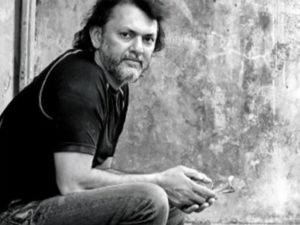 I am also working on a script called 2071, which plays out in 2071 South Asia. It is about the farmer suicides happening today. So if we keep letting them happen and we don’t provide for our farmers, what could happen to us 50 years from today? What is the world we are creating for ourselves and what we are walking into? That is very close to my heart. I have been researching that for quite sometime. This whole issue with genetic seeds and pesticides and cottonseeds and farmers committing suicides – it is all crazy. It has consumed more life than a world war. Why is that if I am a phone manufacturer – I am a rich guy. If I am selling bottle water – I am rich guy. If I am selling denim – I am a rich guy. If I am making computers – I am a rich guy. If I am making Coca Cola – I am a rich guy. If I am doing a stupid job in a bank – I am a rich guy. But the person that is actually filling your stomach is dying of hunger because we are not helping. I really want to address that story one day. I have started working on the screenplay. So one of those will come.
I am also working on a script called 2071, which plays out in 2071 South Asia. It is about the farmer suicides happening today. So if we keep letting them happen and we don’t provide for our farmers, what could happen to us 50 years from today? What is the world we are creating for ourselves and what we are walking into? That is very close to my heart. I have been researching that for quite sometime. This whole issue with genetic seeds and pesticides and cottonseeds and farmers committing suicides – it is all crazy. It has consumed more life than a world war. Why is that if I am a phone manufacturer – I am a rich guy. If I am selling bottle water – I am rich guy. If I am selling denim – I am a rich guy. If I am making computers – I am a rich guy. If I am making Coca Cola – I am a rich guy. If I am doing a stupid job in a bank – I am a rich guy. But the person that is actually filling your stomach is dying of hunger because we are not helping. I really want to address that story one day. I have started working on the screenplay. So one of those will come.
Other than that the company has outgrown me – ROMP pictures has. We have two new directors; one is making a film called Fanney Khan, which stars Anil Kapoor, which is directed by Atul Manjrekar. He used to assist me and then he stared making ad films. He has reinterpreted a US film, which got an Oscar nomination, called Everybody is Famous. He has Indianized that. We got the rights to it almost 5 years ago and we are bringing it to India because it is such a beautiful story. It is a father/daughter story. Then there is Sanjay Khanduri; he’s making a film, which is set in the 1962 China/Indian war. It is about this brave heart [Jaswant Singh Rawat], all of 19-years-old, and how he saved almost 4000 lives. The enemy kind of respected him. They made a bronze bust of his head after he was killed by them and they went back to the Indians and presented it to them saying we respect your soldier. There is a whole town named after him today. These two films are coming up.
Thank you Mr. Mehra once again for another one of my favorite conversations about film! I am truly honored.
After hearing him talk I certainly cannot wait to see Mirzya. From what we have heard so far from early reviews Mirzya is a brilliant film. Be sure to go see it on October 7th!
Also stay tuned we have interviews with Ehsaan Noorani of SEL who sheds even more light on the creation of the incredible music and a fabulous interview with the Harshvardhan Kapoor about being a part of Mirzya.



